Billions needed to meet 95,000 per year affordable housing shortfall, says industry research
Research released today argues that a new funding structure is needed to meet the 95,000 annual shortfall in affordable homes, as well as billions of pounds in additional funding.
Joint research published today by Legal & General (L&G) and the British Property Federation (BPF) highlights the need for a major change in the way affordable housing is funded to overcome the additional £34bn funding required every year to meet long-term societal requirements.
With 1.2 million households on waiting lists in England, an estimated 145,000 affordable homes are needed each year to meet demand, 95,000 more than recent annual delivery.
The research calls upon government to further support a level playing field between both housing associations and investors, to greatly scale the levels of institutional investment in affordable housing that are required to meet the deficit. These include targeted changes to the tax regime and the nature of capital grants provided.
The research additionally highlights the critical importance of rapidly providing a long-term rent settlement to help significantly decrease the subsidy burden on government.
England is facing a chronic undersupply of affordable housing, which will persist without a major increase in capital funding for the sector. L&G and the BPF’s analysis puts the amount of additional capital funding needed to meet affordable housing demand at £34 billion per year.
The report, titled ‘Delivering a step change in affordable housing supply’, examines how the supply of affordable housing, including social rent, affordable rent, and shared ownership, can be increased to meet the nation’s housing need.
Housing associations, who have driven affordable home delivery along with local authorities and central government, are near to borrowing limits and unable to raise new equity due to their not-for-profit status. The report finds that housing associations are currently delivering c.50,000 new homes a year and are realistically only able to deliver up to 65,000 new homes a year, given their funding structure constraints.
In addition, they are now facing major new financial headwinds due to costs associated with decarbonisation of their existing homes and fire remediation programmes. The NHF has estimated the impact of fire safety repairs for the sector as a whole would equate to a non-recoverable funding cost of over £10bn. Further to this net-zero carbon emissions on all homes must be achieved by 2050. A 2020 survey by Inside Housing estimated the total cost of retrofitting the c. 5 million affordable homes owned by RPs and LAs will be £104bn.
Only new capital injection from institutional investors, combined with an increase in grant levels from government can overcome the sector’s current financial limitations. To increase affordable housing delivery to 145,000 new homes per year, the research finds that c.£34bn of additional funding will be required each year which will need to be made up of £10bn of equity from investors, the same from the debt markets and up to £14bn from government grant.
Alongside greatly increasing the provision of affordable housing grant, the report specifically calls upon government to introduce a longer-term rent settlement, providing confidence to housing associations and investors alike to increase output. Additionally, this creates a critical risk reduction, further reducing the amount of grant funding government needs to provide per home.
They also proposed creating a level playing field between housing association and investors through tax positions and grant agreements to remove the obstacles for closer collaboration between institutional investors and Housing Associations.
It also called for a review into subsidy provision to understand the best means of targeting subsidies to increase the supply of affordable housing. This could be through increasing grant levels or supporting new models through co-investment.
Simon Century, managing director of housing at Legal & General, comments, “Our research aims to shine a light on the reality of delivery in the affordable housing sector. The demand for Affordable housing is huge – at best an annual short-fall through time of some 95,000 homes a year. The main existing players – housing associations – can only do so much alone given the huge and increasing demands they face.
He went on: “The only way to overcome the challenges in the years ahead is through a new coming together between all players. Working together, we need to rapidly scale up the amount of long-term institutional investment into the sector, supported by further subsidy from government. This is the only realistic way to deliver more homes at the scale the country so deeply needs.”











